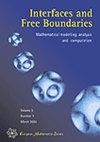带钉钉介质电润湿的有限水平模型预测控制
IF 1
4区 数学
Q1 MATHEMATICS
引用次数: 14
摘要
在最优控制框架下,考虑了具有接触线钉住的时离散空间连续介质电润湿模型的状态系统。该钉钉模型基于互补条件。除了描述速度、压力和电压的物理变量外,固体-液体-空气界面,即接触线,作为随时间变化的几何变量出现。由于存在互补条件,得到的自由边界问题的最优控制是函数空间中具有平衡约束的数学规划。为了应对几何变量,提出了一种有限水平模型预测控制方法。通过应用正则化过程,利用pde约束优化技术,然后传递到正则化参数的极限,得到了对偶平稳条件。此外,根据对偶平稳性条件推导中使用的理论极限论证,建立了基于函数空间的数值过程。通过实例验证了该算法的性能;包括重心匹配和轨迹跟踪。本文章由计算机程序翻译,如有差异,请以英文原文为准。
Finite horizon model predictive control of electrowetting on dielectric with pinning
A time-discrete spatially-continuous electrowetting on dielectric (EWOD) model with contact line pinning is considered as the state system in an optimal control framework. The pinning model is based on a complementarity condition. In addition to the physical variables describing velocity, pressure, and voltage, the solid-liquid-air interface, i.e., the contact line, arises as a geometric variable that evolves in time. Due to the complementarity condition, the resulting optimal control of a free boundary problem is thus a mathematical program with equilibrium constraints (MPEC) in function space. In order to cope with the geometric variable, a finite horizon model predictive control approach is proposed. Dual stationarity conditions are derived by applying a regularization procedure, exploiting techniques from PDE-constrained optimization, and then passing to the limit in the regularization parameters. Moreover, a function-space-based numerical procedure is developed by following the theoretical limit argument used in the derivation of the dual stationarity conditions. The performance of the algorithm is demonstrated by several examples; including barycenter matching and trajectory tracking.
求助全文
通过发布文献求助,成功后即可免费获取论文全文。
去求助
来源期刊
CiteScore
1.70
自引率
0.00%
发文量
17
审稿时长
>12 weeks
期刊介绍:
Interfaces and Free Boundaries is dedicated to the mathematical modelling, analysis and computation of interfaces and free boundary problems in all areas where such phenomena are pertinent. The journal aims to be a forum where mathematical analysis, partial differential equations, modelling, scientific computing and the various applications which involve mathematical modelling meet. Submissions should, ideally, emphasize the combination of theory and application.

 求助内容:
求助内容: 应助结果提醒方式:
应助结果提醒方式:


